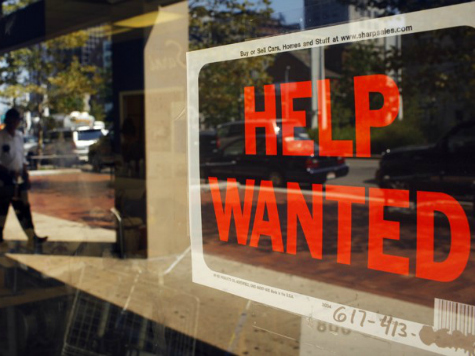
Job creation in the US rose modestly in February, posting a better-than-expected gain of 175,000 despite expectations that weather would keep the count low.
The unemployment rate moved higher to 6.7 percent, according to the latest report from the Bureau of Labor Statistics. A rising unemployment rate is often seen as a good indicator to the extent that more people may be looking for jobs. But the reality behind these numbers is far more complex and should be the focus of attention for conservatives who want to win this November.
The higher jobs number was above the expectations of most economists but still reflects an economy that is creating half as many jobs as there are people entering the workforce. “Economists had forecast nonfarm payrolls rising 149,000 and the unemployment rate to hold steady at 6.6 percent,” Reuters reports.
The employment report is the result of two separate surveys conducted by the Bureau of Labor Statistics. The household survey is a survey of roughly 60,000 households. This survey produces the unemployment rate. The establishment survey is a survey of 375,000 businesses. This survey produces the nonfarm payrolls, average workweek, and average hourly earnings figures, to name a few. Both surveys cover the payroll period which includes the 12th of each month.
“It’s a pretty good report, given the weather,” said Stuart Hoffman, chief economist at PNC Financial Services Group Inc. in Pittsburgh, who correctly predicted the gain in payrolls. “You had a pretty good rise in average hourly earnings, you had some good gains in jobs in a couple of different sectors,” Bloomberg News reports.
The total unemployment rate, which includes discouraged and underemployed workers, moved lower to 12.6 percent from 12.7 percent. This measure better describes the overall state of the U.S. economy, where roughly 300,000 new workers are entering the job market each month. Roughly 10,000 baby boomers are retiring and leaving the workforce every month, but overall the number of people looking for work in the U.S. continues to grow.
What the unemployment situation tells investors and policy makers is that the US economy is still growing at far too slow a rate to offer all of the Americans who want to work gainful employment. One big reason for the poor performance is the sluggish performance of the housing sector, which is running at a fraction of pre-2008 levels in terms of employment, new housing construction and lending.
The National Association of Realtors just reported that one third of all home sales in the US in January were for cash – that is, investors. “Approximately 33 percent of respondents reported cash sales in January,” the NAR reports. “About 13 percent of reported sales made by a first-time buyer were cash sales compared to about 50 to 70 percent for investors and international buyers.”
Even with the anemic job growth rate, officials at the Federal Reserve Board have indicated that they will continue to reduce the amount of direct intervention in the bond market, known as “Quantitative Easing.” Federal Reserve Chair Janet Yellen reiterated the 6.5 percent unemployment threshold in testimony before the Senate Banking Committee, but other Fed officials have made clear that it would take a serious economic reversal before the Fed would change current policy.
In fact, during the February 27 meeting, the Federal Open Market Committee debated “the reliability of the unemployment rate as an indicator of overall labor-market conditions,” minutes of Fed officials’ discussion showed.
“The February jobs report doesn’t change the strong likelihood that the Federal Reserve will cut monthly bond purchases by another $10 billion later this month,” notes Nelson Schwartz at The New York Times. “The numbers were decent. The economy shook off the snow and added jobs. Fed officials won’t be concerned that the unemployment rate ticked up to 6.7 percent.”
But more than worries about which economic indicators matter, Fed officials and other policy makers ought to be worried about the fact that the US economy is still not creating enough jobs to drive consumption and thus GDP growth. Until we start to focus more attention on fixing the housing market, first and foremost, the outlook for job growth is unlikely to change. Conservatives need to focus on the poor performance of the US economy if they want to win power in November 2014.

COMMENTS
Please let us know if you're having issues with commenting.